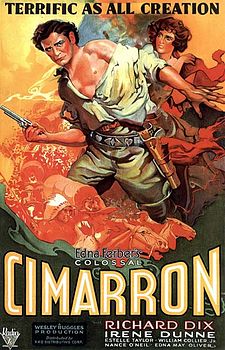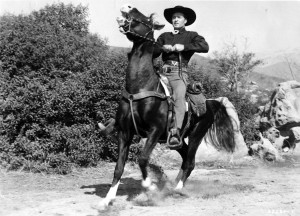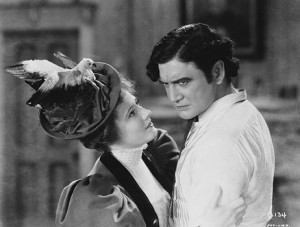Hey, don’t get upset! It’s a matter of taste, and we all love some bad movies, not to mention the fact that a flawed picture might still have some good moments, a powerful performance, impressive cinematography, melodic score, stirring visual and sound effects.
The first bad film to win the Best Picture is Broadway Melody (1929).
The second bad film to win is:
Cimarron (1931)
Only four of the 90 Oscar-winning films have been Westerns: “Cimarron” in 19301, Kevin Costner’s “Dances With Wolves” in 1990, Clint Eastwood’s “Unforgiven,” in 1992, and Joel and Ethan Coen’s “No Country for Old Men” in 2007.

The Western is not a genre that has impressed Academy voters–unless it’s something of the caliber of Stagecoach (1939), directed by John Ford.
Directed by Wesley Ruggles, Cimarron is based on Edna Ferber’s best-selling book about the opening of the Oklahoma frontier, an era that spanned from the late 1890s to late 1930s
Facing hard financial times, RKO took a gamble with “Cimarron,” which covers four decades in the Cravat family and recreates the Oklahoma land rush circa 1888.
Aiming for the epic and visual sweep of silent films, “Cimarron” helped making stars out of its two leads: Richard Dix, a handsome star and previously silent hero, and especially Irene Dunne, who began her career on Broadway in “Show Boat.”
Richard Dix was well cast as the chivalrous adventurer, Yancey Cravat, the dashing, gallant, incorrigible romantic who must always be moving on, amazed to find out that he actually had lived in one place for five years. A vagrant romantic with passion for open spaces, Yancey is the kind of man who would be the first to disappear toward new horizons.
He is by turns an idealistic fighter for unpopular causes, courageous editor, shrewd lawyer, faithful lover of his wife. A unique character, Yancey is periodically attacked with wanderlust, nonchalance, and impulsiveness.
 Referring to the Oklahoma Land Rush, Cravat states: “Creation. That took six days. This was done in one. History made in an hour. Why, it’s like a miracle out of the Old Testament.”
Referring to the Oklahoma Land Rush, Cravat states: “Creation. That took six days. This was done in one. History made in an hour. Why, it’s like a miracle out of the Old Testament.”
Religion is evoked again, when Cravat talks about the new newspaper: “The Oklahoma Wigham prints all the news all the time, knowing no law except the law of God and the government of the United States.”
Irene Dunne plays the indomitable Sabra Cravat, Yancey’s sterling wife, who sticks to the newspaper, the Oklahoma Wigwam that her hubby had founded. Sabra starts as a fragile wife, but after being deserted by Yancey, she learns how to carry on valiantly, editing the local paper in his place and eventually becoming a congresswoman.
It’s Sabra who occupies the narrative center, and enlists our sympathy, particularly after Yancey deserts the family and goes to the Cherokee Strip. When he returns, five years later, Yancey asks his wife if she had missed him!
Cravat is constructed as a legendary, mythical, not entirely understood, figure. This is expressed in a dialogue scene between Sol Levy (George E. Stone), talking to Sabra, who has not heard from her husband in years. Levy says: “They will always talk about Yancey. He’s going to be part of the history of the great Southwest. It’s men like him that build the world. The rest of them, like me, we just come along and live in it.”
Aiming for an epic sweep, the tale shows changes in character and scenery as the community grows into a hustling modern town.
The Cravats’ level of tolerance is tested, when their son Crim becomes enamored of an Indian girl and then marries her. Yancey’s editorial is in favor of the Indians, and though frowned upon at first by his wife, it’s eventually reprinted on every anniversary of its appearance.
Oscar Context
Cimarron won three Oscars, Best Picture, Writing Adaptation (Howard Estabrook) and Interior Decoration (Max Ree).
It also earned lead nominations (the Supporting Acting categories did not yet exist) for the two lead protagonists, Dix and Dunne; director Ruggles; and cinematographer Edward Cronjager.
Norman Taurog won the Best Director Oscar for “Skippy”; Lionel Barrymore the Actor Oscar for “A Free Soul”; Marie Dressler the Best Actress Oscar for “Min and Bill”; Floyd Crosby the Cinematography Oscar for “Tabu.”
RKO Radio Pictures invested more than $1.5 million into their epic production. Filming began in the summer of 1930 at Jasmin Quinn Ranch outside of Los Angeles, where the land rush scenes were shot. Numerous cameramen, extras, wagons, were used by the studio, which purchased 89 acres in Encino, where construction of Art Director Max Ree’s Oscar winning design of a western town was built to represent the Oklahoma fictional boomtown of Osage.
(These sets in Encino were used for other RKO films, as well as other features, such as Capra’s It’s a Wonderful Life, in 1946).
RKO premiered their wannabe epic–actually a period soap melodrama–at the RKO Palace Theatre in New York on January 26, 1931, and then on February 6 of that year at the Los Angeles Orpheum Theater. The event included personal appearances of Richard Dix and Irene Dunne, a stage show, and a full orchestra.
Commercial Appeal:
While it was a commercial success, initially, due to the Depression, RKO did not recoup their investment in the film, which lost over half a million dollars. However, it earned more money on later re-releases.
The movie continued to remain RKO’s most expensive production until the 1939 adventure Gunga Din.
Cast
Richard Dix as Yancey Cravat
Irene Dunne as Sabra Cravat
Estelle Taylor as Dixie Lee
Nance O’Neil as Felice Venable
William Collier Jr. as The Kid
Roscoe Ates as Jesse Rickey
George E. Stone as Sol Levy
Stanley Fields as Lon Yountis
Robert McWade as Louis Hefner
Edna May Oliver as Mrs. Tracy Wyatt
Judith Barrett as Donna Cravat












